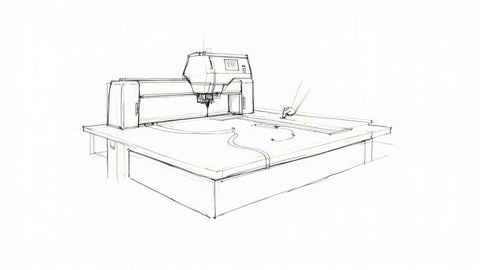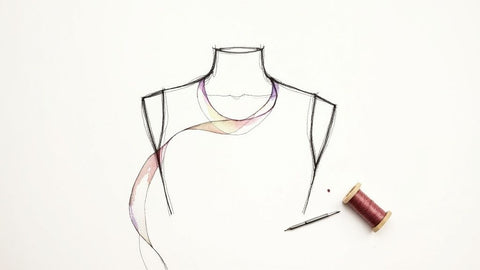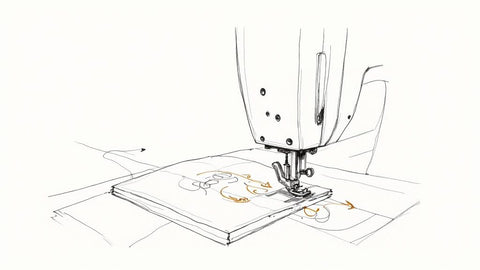If you’ve ever tried to quilt a big project on your home sewing machine, you know the struggle. It's a full-body workout, wrestling all that fabric through a tiny opening. That’s where longarm quilting comes in, and it's a complete game-changer for crafters looking to create stunning designs.
Instead of shoving and pulling your quilt under a stationary needle, longarm quilting flips the script. Your quilt—the top, batting, and backing—gets stretched out nice and taut on a large frame. Then, you move a large, free-floating sewing machine head over the fabric. It’s a totally different way of thinking about the quilting process, allowing you to focus on the artistry of the design.
This approach makes it possible to finish huge quilts with incredible speed, ease, and a level of precision that’s tough to match at home, empowering you to replicate beautiful, tangible examples of quilt designs.
What Is Longarm Quilting?
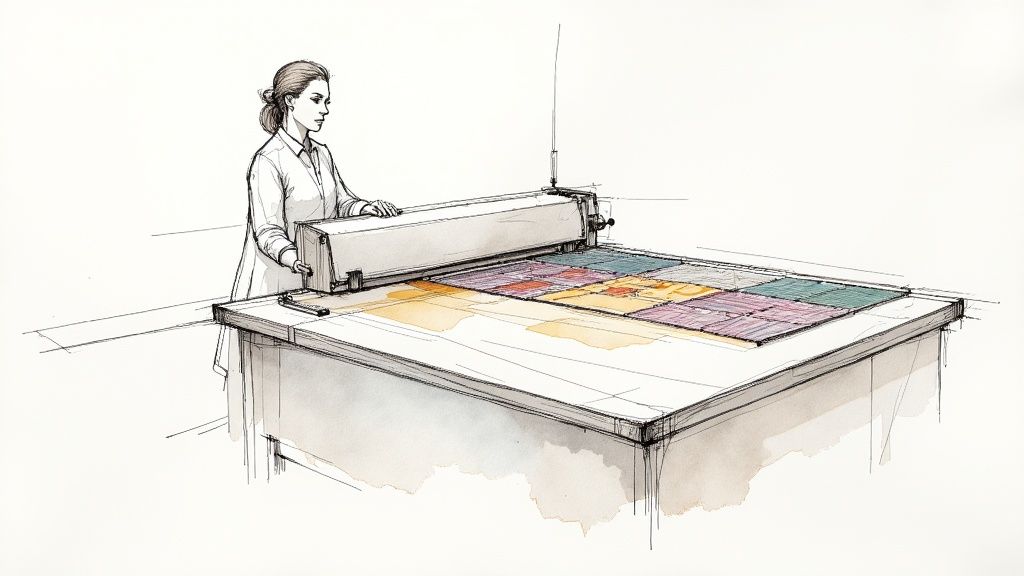
Think of it like this: trying to paint a giant mural with a tiny artist's brush would be incredibly frustrating and take forever, right? A longarm quilting machine is like upgrading to a professional paint sprayer. It’s the right tool for the scale of the job, giving you the freedom to create smooth, sweeping designs or tiny, intricate details with way less effort.
Because the quilt layers are mounted on a frame under even tension, you get to skip the grueling task of basting. No more crawling around on the floor with safety pins! This frees you up to just focus on the artistry and the joy of stitching your masterpiece together.
Domestic Machine Quilting vs Longarm Quilting
To really get a feel for the difference, it helps to see a side-by-side comparison. Quilting on a domestic machine is an amazing skill, but a longarm is a specialized tool built for one job.
| Feature | Domestic Machine Quilting | Longarm Quilting |
|---|---|---|
| Movement | You move the fabric under a fixed needle. | You move the machine head over fixed fabric. |
| Workspace | Limited by the machine's "throat space" (typically 5-11 inches). | Massive workspace; the entire frame (often 10-14 feet). |
| Fabric Handling | Requires basting; quilt must be rolled and maneuvered. | Fabric layers are loaded onto a frame; no basting needed. |
| Project Size | Challenging for anything larger than a throw quilt. | Easily handles quilts of all sizes, including king-sized. |
| Stitch Quality | Stitch length can vary with fabric pushing/pulling. | Often has stitch regulation for perfectly consistent stitches. |
| Learning Curve | Steeper for free-motion on large quilts due to fabric drag. | Focused on controlling the machine's movement, not the quilt. |
Ultimately, both methods create beautiful quilts, but the process and experience are worlds apart. A longarm simply removes many of the physical barriers that can make finishing a large quilt feel like a monumental chore.
The Evolution of Quilting Technology
Longarm quilting as we know it really took off in the late 20th century. Quilters were pushing the boundaries of their craft and needed a better way to bring their complex, large-scale visions to life. The demand for greater efficiency and creative freedom drove the evolution from hand quilting and small domestic machines to these incredible systems. If you're interested in the nuts and bolts, you can read more about the stationary longarm quilting machine market evolution to see just how far the technology has come.
Here at bsewinn.com, we've seen this evolution up close. Our commitment is to empower crafters like you by providing not just custom sewing machine designs, but a whole support system to go with them. We want to help you create tangible, replicable designs with confidence.
We believe in empowering you through:
- Hands-on Training: Our online classes are designed as comprehensive how-to guides, building your skills one step at a time and making even the most complex designs feel achievable.
- Extensive Resources: We've built an extensive library of resources to help you master your machine, from your first stitch to creating breathtakingly intricate designs.
- A True Community: When you work with us, you're not just a customer. You're joining a network of passionate quilters who share your love for the craft and are always there to cheer you on.
Longarm quilting is so much more than just a technique. It’s a key that unlocks your creative potential, allowing you to tackle those ambitious projects you’ve been dreaming about but thought were impossible on your home machine. It turns the final, often most dreaded, stage of quilting into one of the most enjoyable parts of the entire process.
How a Longarm Quilting Machine Actually Works
To really get what longarm quilting is all about, you have to understand the machine itself. They can look pretty intimidating, but the principle behind them is surprisingly simple: the machine moves while the fabric stays still. That one core difference is what turns quilting a massive project from a chore into a joy.
Think of it this way: the machine’s sewing head is like a high-tech pen, and the huge frame is a canvas stretcher. Your quilt layers—the top, batting, and backing—are carefully loaded onto rollers on the frame, which holds everything perfectly smooth and taut. No more puckers, no more shifting.
Your job, as the quilter, is to guide this “pen” across the fabric canvas to draw with stitches. You're no longer wrestling a heavy, bunched-up quilt through the small throat of a domestic sewing machine. Instead, you stand comfortably and guide the machine head with a light touch, allowing for fluid, graceful movements that become beautiful, even quilting.
The Core Components Working in Harmony
Three key parts work together to make this whole process feel so seamless: the rollers, the handlebars, and the stitch regulator. Each one has a specific job, and when you understand what they do, you'll feel a lot more confident stepping up to the frame. The incredible precision of a longarm machine comes from how these parts cooperate to produce flawless results.
This infographic breaks down how these three essentials team up.
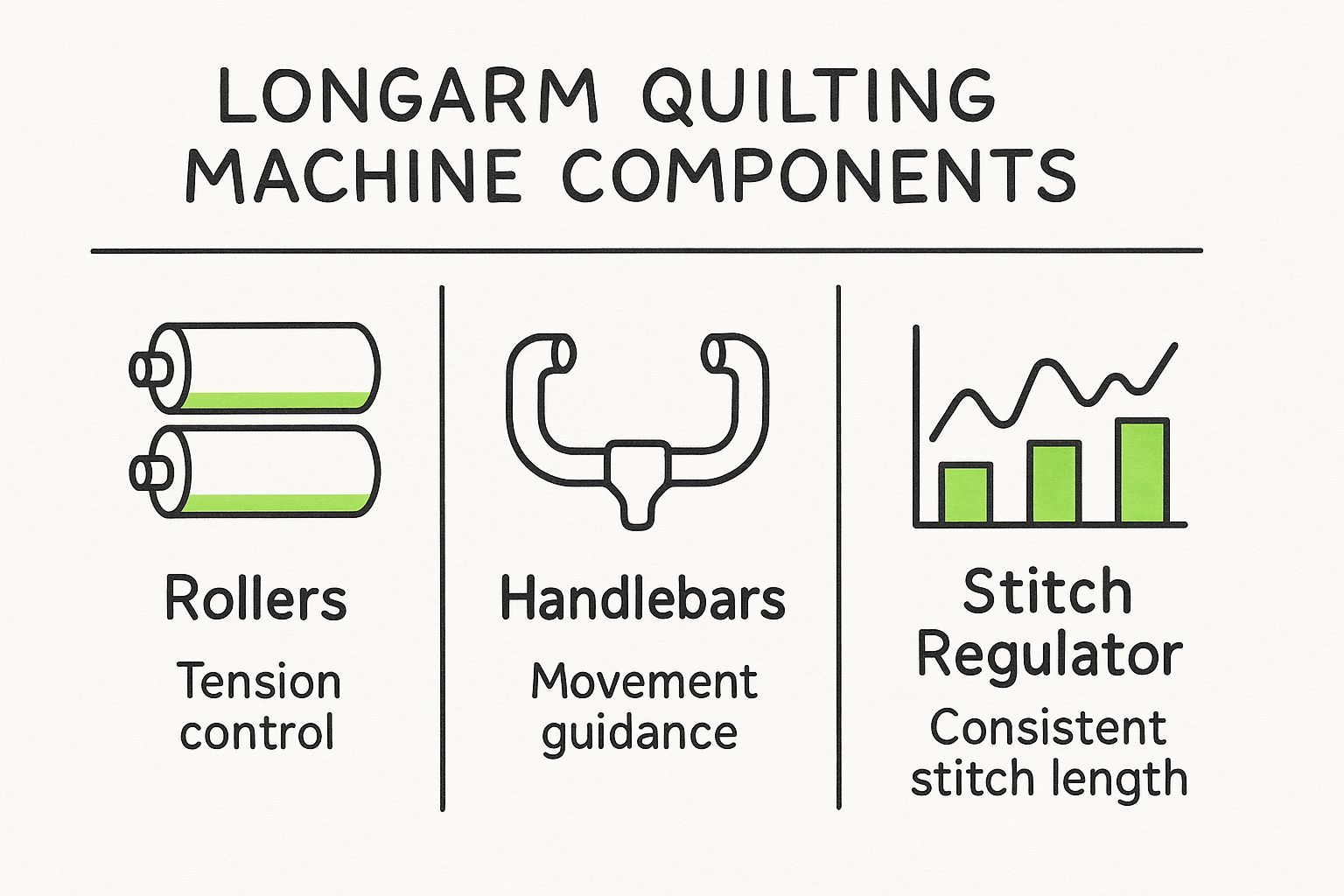
As you can see, the rollers handle fabric tension, the handlebars give you directional control, and the stitch regulator makes sure every single stitch is perfect.
Let's dig a little deeper into how they work:
- The Rollers and Frame: The frame system has a few rollers. One holds your quilt backing, another holds the quilt top, and a "take-up" roller neatly winds up the finished section as you go. They all work in sync to keep consistent, even tension across the entire quilt—the secret weapon for preventing puckers and tucks.
- The Handlebars: This is how you "drive" the machine. Located on both the front and back of the sewing head, you use them to steer the machine across the fabric. They’re designed to be ergonomic, so you can quilt for hours, creating everything from simple straight lines to incredibly intricate free-motion designs.
- The Stitch Regulator: This might be the most magical part of the whole setup. The stitch regulator is a small sensor that knows exactly how fast you're moving the machine. When you move fast, the needle speeds up; when you slow down for a tricky curve, the needle slows down right along with you.
This amazing bit of tech ensures that every single stitch is the exact same length, no matter how fast or slow you move. It’s the secret to getting that polished, professional finish that makes a quilt truly stand out.
At bsewinn.com, we know that learning a new machine can feel like a lot. That's why our custom sewing machine designs are backed by supportive online classes and training. We’ll walk you through every component in a clear how-to format, from loading the frame to mastering the stitch regulator, so you feel empowered and ready to create.
For a great example of a user-friendly system, check out the Baby Lock Gallant XL long arm quilting machine and its frame—it’s a fantastic machine for quilters ready to make the leap.
Manual vs. Computerized Longarms: Which Is Right for You?
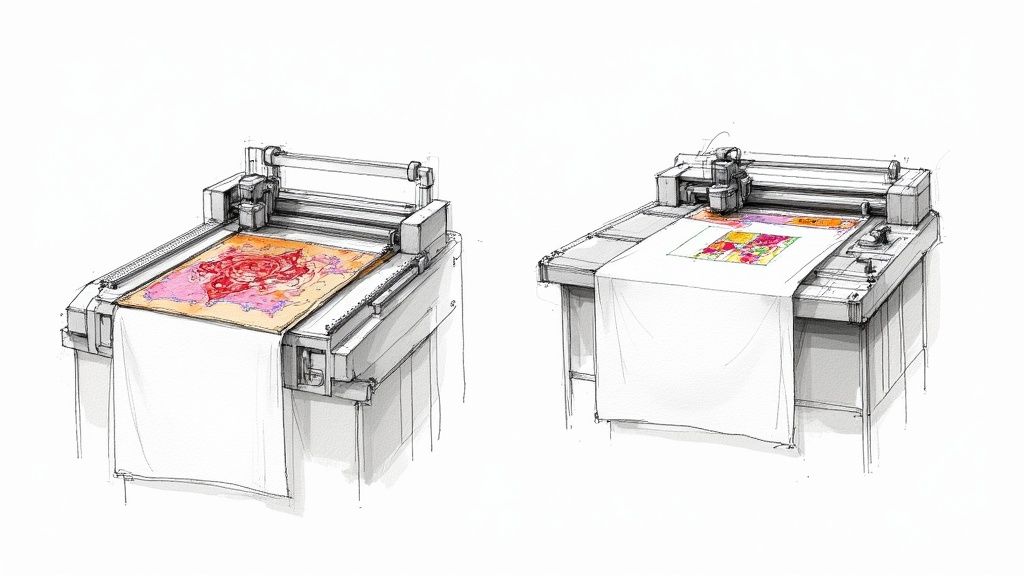
When you start digging into the world of longarm quilting, you’ll quickly discover there are two main paths you can take: manual or computerized. There’s no right or wrong answer here; the best choice really comes down to your personal quilting style and what you hope to achieve with your machine.
Let’s break them down.
The Artist's Touch: Manual Hand-Guided Quilting
A manual, or hand-guided, longarm is all about the human touch. Think of it as freehand drawing, but with a sewing machine. You’re the one in control, standing at the machine, hands on the grips, guiding the sewing head across the fabric to create your design.
This method is perfect for quilters who love that direct, tactile connection to their work. Every swirl, feather, and stipple is a direct result of your own movement, infusing each quilt with a unique, spontaneous artistry that can't be perfectly replicated. It’s an incredible way to develop your free-motion quilting skills.
Your creativity is the only limit. Manual quilting allows for improvisation and artistic expression in real-time, making each quilt a direct reflection of the quilter's hand and heart.
The Engineer's Precision: Computerized Quilting
On the other side, you have computerized longarm quilting. This is where technology steps in to deliver incredible precision and automation. Instead of guiding the machine yourself, you use software to pick a digital design—or even create your own.
Once you’ve set the pattern, you just hit "start," and the machine takes over, executing the design perfectly from one edge of the quilt to the other. The stitch consistency is flawless, allowing you to tackle incredibly complex and intricate patterns that would be a massive challenge to quilt by hand. This is ideal for creating tangible examples that can be perfectly replicated every time.
Which Path Should You Choose?
Deciding between a hand-guided and a computerized system depends entirely on your quilting personality. Do you crave the freedom to improvise and leave your personal mark, or do you value precision, efficiency, and the ability to replicate complex designs flawlessly?
To help you sort it out, here’s a look at how they stack up side-by-side.
Manual vs Computerized Longarm Systems
| Aspect | Manual (Hand-Guided) | Computerized |
|---|---|---|
| Control | 100% quilter-controlled. Every movement is your own. | Automated control via software. |
| Designs | Organic, free-motion, custom ruler work. Great for one-of-a-kind artistry. | Digital patterns (pantographs), intricate designs, custom digital layouts. |
| Skill Required | Requires practice to develop muscle memory and consistency. | Primarily requires software and design setup skills. |
| Precision | Relies on the quilter's skill. Can have a beautiful, handmade look. | Flawless, stitch-perfect results every time. |
| Speed | Varies based on quilter's speed and design complexity. | Generally faster for complex, all-over designs. |
| Best For | Artistic quilters, those who love free-motion, custom projects. | Production quilters, intricate pattern lovers, business owners. |
| Cost | Typically a lower initial investment. | Higher initial investment due to software and hardware. |
Ultimately, both systems can produce stunning quilts. Many quilters start with a manual machine and later add a computerized system, getting the best of both worlds.
Computerized systems are a total game-changer for quilters who want to run a business or simply finish more quilts with professional, repeatable results. At bsewinn.com, we see more and more crafters gravitating toward automation for its precision. If you're intrigued by what's possible, you can add a system like the Baby Lock Pro-Stitcher 6 quilting robotics software to a compatible machine, turning it into a high-precision instrument.
Whether you’re drawn to the artistic freedom of manual quilting or the flawless execution of a computerized system, bsewinn.com has the custom sewing machine designs, online classes, and extensive resources to empower you on your journey.
So, What's the Big Deal About Longarm Quilting?
Why would anyone make the jump to a longarm? Sure, speed is a huge part of it, but the real magic goes so much deeper. It’s not just about finishing quilts faster; it's about completely changing how you feel during the process. Think of it as upgrading your creative experience from a physical chore to pure, joyful flow.
The first thing you’ll notice is the incredible jump in the professional quality of your quilts. Since the frame holds all three layers in perfect, even tension, you can finally wave goodbye to those frustrating puckers, tucks, and fabric shifts that can ruin a project on a domestic machine. This perfectly stable canvas, paired with slick features like a stitch regulator, means every single stitch is consistent and beautifully formed. It gives your quilts that polished, high-end finish that’s so tough to get when you’re wrestling a giant quilt sandwich.
Comfort and Creative Freedom
One of the biggest—and most underrated—perks is all about ergonomics. If you've ever quilted on a domestic machine, you know the drill: hours spent hunched over, leading to serious neck, shoulder, and back pain. That physical strain can completely zap your creative energy and force you to quit for the day.
Longarm quilting flips that script entirely. You’re standing, guiding the machine with a light touch, and maintaining a natural, upright posture. It sounds like a small change, but the impact is massive. Your comfort and stamina go way up, letting you quilt for hours without the aches and pains. It literally saves your body, making quilting a sustainable, enjoyable hobby for years to come.
Imagine finishing a king-sized quilt with zero back pain. That's not just a small perk; for many quilters, it’s the single biggest reason they switch. The ergonomic relief is a true game-changer.
Taking On Ambitious Projects with Ease
The sheer size and power of a longarm machine open up a whole new universe of creative possibilities. Those projects that once seemed impossibly huge—like a sprawling California king quilt—suddenly become totally doable.
It just removes all the biggest roadblocks:
- No More Basting: You can completely ditch the tedious, floor-sprawling task of pinning or spray-basting your quilt layers together. Seriously.
- Effortless Fabric Handling: The machine moves, not the quilt. You will never again have to shove, pull, and rotate a heavy, bulky quilt through a tiny machine throat.
- Unrestricted Movement: You have total freedom to create big, sweeping, gorgeous designs across the entire quilt without constantly stopping to readjust the fabric.
This isn't just about speed; it's about unlocking your creative brain. Here at bsewinn.com, we’re all about that creative liberation. Through our hands-on machine setups, online classes, and wealth of resources, we help quilters break free from the physical limits of their old setup and finally bring their biggest, boldest quilting dreams to life.
Inspiring Longarm Quilting Designs You Can Create
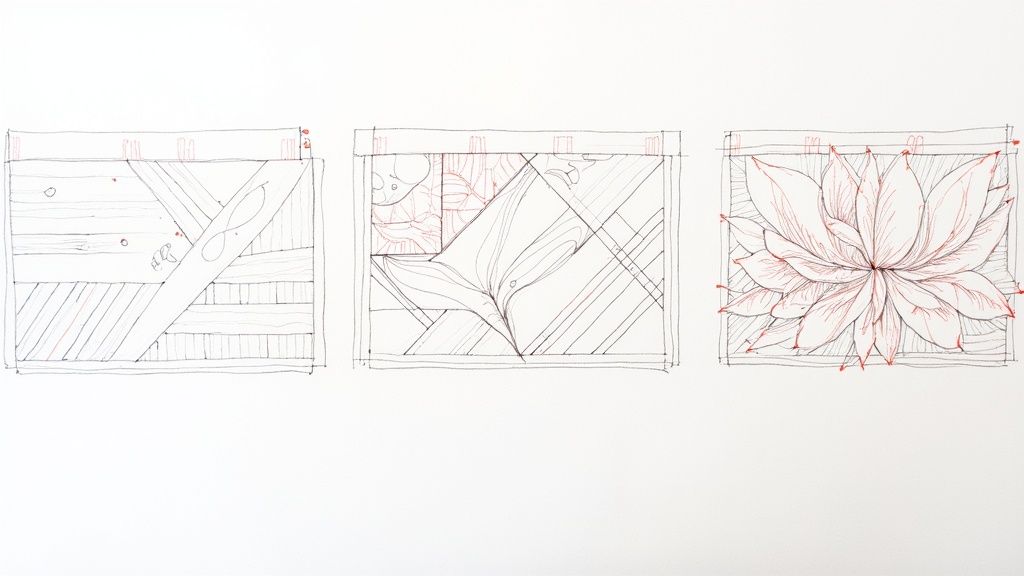
This is where the real fun begins. Knowing how a longarm works is one thing, but seeing the incredible designs you can create is what really gets the creative juices flowing. This how-to guide will showcase a few tangible examples that you can replicate. A longarm’s versatility lets you stitch an amazing range of textures and patterns, turning a simple quilt top into a true work of art.
Whether your style is modern and minimal or classic and elegant, there’s a longarm technique that can bring your vision to life. Let’s look at a few popular designs that show off the creative power you can unlock.
Edge-to-Edge Pantograph Designs
Pantographs, often called edge-to-edge (E2E) designs, are continuous line patterns that cover the entire quilt from one side to the other. They're a fantastic way to add a beautiful, consistent texture across your quilts without a huge time commitment.
These replicable designs are a crafter's best friend, especially when using a computerized system that executes the pattern with flawless precision. Some go-to pantograph styles include:
- How-To Replicate Flowing Loops and Swirls: These organic, curvy patterns give a quilt a soft, playful feel. To create this design, select a digital pattern like "Liquid" or "Wishbone." This will create a gentle, meandering texture that works with just about any quilt top, modern or traditional.
- How-To Replicate Crisp Geometric Patterns: For a more contemporary vibe, geometric E2E designs are perfect. To achieve this, choose a design with interlocking hexagons, clean straight-line grids, or repeating chevrons. This adds structure and a modern edge, especially on quilts with bold, graphic piecing.
With the right setup, you can finish an entire quilt with a stunning all-over pattern in just a fraction of the time it would take to quilt by hand.
Custom Quilting Techniques
When you want to make specific blocks, borders, or sections of your quilt really stand out, custom quilting is the way to go. This approach is all about using different designs in different areas of the quilt, which requires a more hands-on, artistic touch.
Custom work turns the quilting itself into a primary design element. It’s how you use thread to tell a story, drawing the eye to the parts of your piecing you’re most proud of.
Two of the most beloved custom techniques are ruler work and feather motifs. They’re classics for a reason!
- How-To Create Intricate Ruler Work: By guiding the machine’s hopping foot along specialty acrylic rulers, you can stitch perfectly straight lines, smooth arcs, and complex geometric shapes. This tangible example is amazing for outlining blocks, creating detailed crosshatching, and adding sharp, precise details that make a quilt pop.
- How-To Create Elegant Feather Motifs: Feathers are a timeless quilting design that will never go out of style. You can stitch them free-hand for a soft, organic look or use stencils for perfect symmetry. Either way, feathers add a touch of grace and sophistication to any project, especially in borders and sashing.
At bsewinn.com, our online classes are structured as comprehensive how-to guides to walk you through these exact techniques. We empower crafters by providing the step-by-step guidance and extensive support you need to confidently tackle everything from your first pantograph to intricate custom feather work, helping you create the stunning quilts you’ve always dreamed of making.
So, What's Next on Your Longarm Journey?
Feeling that spark? Are you ready to stop wrestling with your quilt top and start gliding across it instead? That first step into the world of longarm quilting is a big one, but it's exciting, and you definitely don't have to take it alone. The path from a curious quilter to a confident longarm artist is clearer than you might think.
A fantastic way to start is to get some hands-on time without the huge commitment of buying a machine right away. Lots of local quilt shops actually rent out time on their longarms. It's a perfect, low-cost way to just try it out. You get a real feel for how the machine moves and can even finish a project with an expert right there to help.
We're Here to Help You Grow
As you start figuring out what is longarm quilting, you'll quickly realize that having the right support system changes everything. Here at bsewinn.com, our commitment is to empower crafters like you. We don't just sell machines; we've built a whole world of support designed to help you succeed.
We want you to feel confident from the moment you start. Here’s how we support you:
- Online Classes You Can Actually Follow: Our how-to guides teach you everything from the basics to advanced design creation, all at your own pace.
- A Library of Training Resources: Got a question? We've probably got a video or a guide to answer it.
- A Community That Gets It: Connect with other quilters who are just as passionate as you are.
Getting into longarm quilting is so much more than just buying a new piece of equipment—it's an investment in your own skill and creativity. With the right people in your corner, you can unlock a whole new level of artistry and find even more joy in your craft.
We'd love to be your trusted partner as you take this exciting leap. To get a feel for how we break things down, check out our comprehensive Sit-Down Long Arm Quilting Machine Class. It's a great peek into how we turn complex topics into simple, learnable steps, setting you up for a truly amazing quilting adventure.
Your Top Longarm Quilting Questions, Answered
Taking the plunge into longarm quilting is a huge step, and it's totally normal to have a million questions swirling around. I hear from quilters all the time who are worried about the space, the cost, and whether they have the skills to handle such a big machine. Let’s tackle some of those common worries head-on so you can feel good about your next move.
How Much Room Do I Really Need for a Longarm?
This is usually the first thing people ask, and for good reason! The honest answer is: it all comes down to the frame. The machine itself is the smaller part of the equation; it's the frame that dictates the footprint.
A more compact setup, maybe one meant for smaller quilts or tight spaces, could tuck into a spot that’s about 10 feet wide by 5 feet deep. But if you’re dreaming of quilting up those king-sized beauties, you’ll need a bigger frame. Those often demand a dedicated space that's 12 to 14 feet long, sometimes even more. The trick is to measure not just for the frame, but for you! You need enough room to walk all the way around it to load fabric, do maintenance, and just move freely.
Is Getting into Longarm Quilting Crazy Expensive?
Let's not sugarcoat it—the initial investment can feel pretty steep. A longarm machine can set you back anywhere from a few thousand dollars for a more basic model to over $30,000 for a computerized system with all the bells and whistles. That number alone can stop a quilter in their tracks.
But here’s the good news: you don't have to buy one to get started. More and more quilt shops are offering rental time on their in-house longarms. This is an absolutely fantastic way to finish your own quilts, get a feel for the process, and see if it’s the right fit for you without that major financial commitment.
Do I Have to Be a Quilting Pro to Use a Longarm?
Not at all! I know they look intimidating, but these machines are actually designed to be surprisingly user-friendly. In fact, a lot of quilters find it easier than wrestling a big quilt under the needle of their domestic machine. Think about it: instead of shoving and pulling a heavy quilt, you're guiding a lightweight machine head that glides like butter.
The whole learning process shifts from managing bulky fabric to simply guiding the machine. With a little bit of foundational training, even a total beginner can start quilting with beautiful, consistent stitches that look incredibly professional.
This is exactly where we come in. Here at bsewinn.com, our online classes and extensive resources are all about taking the mystery out of the process. Our commitment is to empower crafters with the right custom sewing machine designs and in-depth training to truly master the art. We're here to make sure you feel confident and inspired from the very first stitch.
At bsewinn.com, our mission is to fuel your creative journey with the best tools and education out there. Take a look at our huge selection of sewing and quilting machines, accessories, and online classes to elevate your craft. Find the machine you've been dreaming of today at https://www.bsewinn.com.

